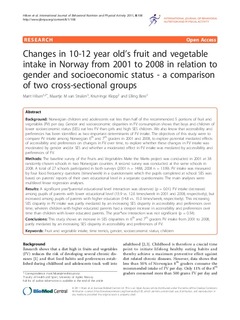| dc.contributor.author | Hilsen, Marit | |
| dc.contributor.author | van Stralen, Maartje M. | |
| dc.contributor.author | Klepp, Knut-Inge | |
| dc.contributor.author | Bere, Elling | |
| dc.date.accessioned | 2011-11-30T13:32:35Z | |
| dc.date.available | 2011-11-30T13:32:35Z | |
| dc.date.issued | 2011 | |
| dc.identifier.citation | Hilsen, M., van Stralen, M., Klepp, K.-I., & Bere, E. (2011). Changes in 10-12 year old's fruit and vegetable intake in Norway from 2001 to 2008 in relation to gender and socioeconomic status - a comparison of two cross-sectional groups. International Journal of Behavioral Nutrition and Physical Activity, 8(1), 108. doi: 10.1186/1479-5868-8-108 | no_NO |
| dc.identifier.issn | 1479-5868 | |
| dc.identifier.uri | http://hdl.handle.net/11250/139001 | |
| dc.description | Published version of an article in the journal: International Journal of Behavioral Nutrition and Physical Activity. Also available from the publisher BMC: http://dx.doi.org/10.1186/1479-5868-8-108. Open Access | no_NO |
| dc.description.abstract | BACKGROUND:Norwegian children and adolescents eat less than half of the recommended 5 portions of fruit and vegetables (FV) per day. Gender and socioeconomic disparities in FV consumption shows that boys and children of lower socioeconomic status (SES) eat less FV than girls and high SES children. We also know that accessibility and preferences has been identified as two important determinants of FV intake. The objectives of this study were to compare FV intake among Norwegian 6th and 7th graders in 2001 and 2008, to explore potential mediated effects of accessibility and preferences on changes in FV over time, to explore whether these changes in FV intake was moderated by gender and/or SES and whether a moderated effect in FV intake was mediated by accessibility and preferences of FV.METHODS:The baseline survey of the Fruits and Vegetables Make the Marks project was conducted in 2001 at 38 randomly chosen schools in two Norwegian counties. A second survey was conducted at the same schools in 2008. A total of 27 schools participated in both surveys (2001 n = 1488, 2008 n = 1339). FV intake was measured by four food frequency questions (times/week) in a questionnaire which the pupils completed at school. SES was based on parents' reports of their own educational level in a separate questionnaire. The main analyses were multilevel linear regression analyses.RESULTS:A significant year*parental educational level interaction was observed (p = 0.01). FV intake decreased among pupils of parents with lower educational level (13.9 vs. 12.6 times/week in 2001 and 2008, respectively), but increased among pupils of parents with higher education (14.8 vs. 15.0 times/week, respectively). This increasing SES disparity in FV intake was partly mediated by an increasing SES disparity in accessibility and preferences over time, wherein children with higher educated parents had a steeper increase in accessibility and preferences over time than children with lower educated parents. The year*sex interaction was not significant (p = 0.54).CONCLUSIONS:This study shows an increase in SES disparities in 6th and 7th graders FV intake from 2001 to 2008, partly mediated by an increasing SES disparity in accessibility and preferences of FV. | no_NO |
| dc.language.iso | eng | no_NO |
| dc.publisher | Biomedcentral | no_NO |
| dc.title | Changes in 10-12 year old's fruit and vegetable intake in Norway from 2001 to 2008 in relation to gender and socioeconomic status - a comparison of two cross-sectional groups | no_NO |
| dc.type | Journal article | no_NO |
| dc.type | Peer reviewed | no_NO |
| dc.subject.nsi | VDP::Medical disciplines: 700::Health sciences: 800::Nutrition: 811 | no_NO |
| dc.source.pagenumber | 1-8 | no_NO |
| dc.source.volume | 8 | no_NO |
| dc.source.journal | International Journal of Behavioral Nutrition and Physical Activity | no_NO |
| dc.source.issue | 1 | no_NO |
